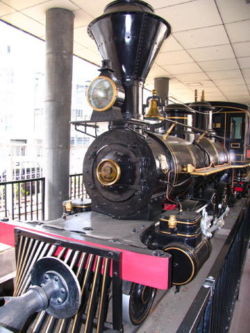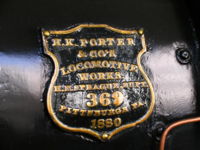7100 steam locomotive
The Japan National Railways (JNR) 7100 series steam locomotive was first used in Hokkaidō, upon the establishment of the government-sponsored Horonai Railway in 1880. The locomotives were imported from the United States.
The locomotives were produced by the American company H. K. Porter, Inc. Two were purchased in 1880 (Nos. 368, 369), two more in 1882 (Nos. 487, 488), one in 1884 (No. 643), one in 1885 (No. 672), and two more in 1889 (Nos. 1009, 1010), for a total of eight. Six of the locomotives were named after major historical or literary figures in 1889, at the suggestion of the Japanese Consul of New York City, Takagi Saburō, who found appeal in the similar practice seen in the United States at the time. Thus, the six became known as Yoshitsune, Benkei, Hirafu, Mitsukuni, Nobuhiro, and Shizuka.
History
Service began between Sapporo and Temiya on 28 November 1880, via Yoshitsune and Benkei. The following year, on 30 August 1881, Emperor Meiji rode the line, called Kaitakushi-gō (開拓使号, "Settlement Envoy"). Pulling nine cars in poor weather, the train arrived late, but this was said to be acceptable; it is not clear which locomotive was used. The line was extended in 1882 to connect Sapporo with Horonai, and Hirafu and Mitsukuni were obtained. Nobuhiro and Shizuka were purchased soon afterwards, and in 1887 a Baldwin Locomotive Works 1-C tender was also purchased, which was given the series number 7170. When the last of the H.K. Porter locomotives were purchased, the trains' ordinals were rearranged to group the Porters together.
The railway company changed ownership in 1889, the Hironai Railway being sold to the Hokkaidō Coal Railway. Under this company, the locomotives were ruined, their smokestacks, cowcatchers, and other features changed or removed. Ten years later, the seventh train (#1009) was purchased by the Hokkaidō government railway and repaired; but it barely saw service, and was only used to aid in construction and to plow snow.
The Hokkaidō Coal Railway, and thus all the 7100 series locomotives, came under the control of the government in 1906, with the passage of the Railway Nationalization Act, which incorporated it into the Japan National Railway. The numbering of train series was standardized and formalized in 1909, officially establishing these eight locomotives as the 7100 series (7100-7107). Some changes were made to the vehicles, in particular the one purchased by the government in 1899, which was made to have two separate repeat-transferring boilers. Three vehicles were left entirely unaltered. At this point, No. 7103 was traded away, while the other seven entered service under the Hokkaidō governmental construction bureau.
In 1915, efforts were made by a Hakodate factory to reunite the eight locomotives, but 7103 was experiencing hunting oscillation problems; information regarding its condition, as well as repair reports, cannot be found, and thus its fate remains uncertain today. Beginning in 1917, the eight were scrapped or sold. Japan Steel Works, Ltd. purchased and scrapped 7106 in that year. The Hokkaidō governmental construction bureau purchased 7100, 7102, and 7107 in 1923, and Teikoku Railways, then known as Baihatsu Steel, bought 7104 and 7105 two years later. Baihatsu would later sell 7104 to the Kōchi Railroad Company (now Tosa Electric Railway) which used it for construction and then destroyed it. Locomotive 7101 was initially left intact and shipped to Tokyo, but it too was scrapped soon afterwards.
Conservation
A replica of Yoshitsune (7101) was included in the original exhibitions of the Railway Museum upon its opening in Tokyo in 1922 (the Railway Museum later became the Transport Museum and closed in 2006). Another Yoshitsune, possibly the original, was sent to the museum from Hokkaidō that following year. That same year, however, saw the 1923 Great Kantō earthquake which destroyed a great portion of the city; One of the two was placed in a storage shed at Kuroiso station and neglected for over ten years, while the other was scrapped.
It was decided that Benkei would be conserved in Sapporo. The Sapporo Railways Handicrafts Office then examined the remains of the scrapped engines, and attempted to trace the remnants to the individual engines of the 7100 series, and to the ones purchased from H.K. Porter. Their findings were actually surprising, reassessing the entire history of which model/series numbers and names belonged to which trains, and in what years they were manufactured. It was decided to conserve Shizuka (7106), but the Japan Steel Works Ltd. felt it was unnecessary. Ultimately, a trade was worked out in which the corporation received scrap metal in exchange for returning the locomotive.
Yoshitsune was restored in 1936 at the Ōmiya factory (now the JR East Ōmiya General Rolling Stock Center). That year, again, however, a pair of railroad enthusiasts examined the trains and determined that 7105 was in fact Yoshitsune, and that 7101, which had been considered as Yoshitsune was in fact Benkei. Restoration was completed in 1940, and 7101, now labeled Benkei, was placed in the Railway Museum. Though it remains on display outdoors today, it is planned to be moved to the new Museum of Railway in Saitama Prefecture upon its opening in 2007.
Those engines which had been purchased by the Hokkaidō construction bureau continued to be used for those purposes until 1950, when they were sent to the JNR Naebo factory. 7100 was used in an exhibition for the 70th anniversary of the Hokkaidō railroad, but 7102 was dismantled in 1952. That same year, in honor of the 80th anniversary of certain railroad operations in Japan, it was decided that Yoshitsune, now identified as 7105, would be restored at the factory in Takatori. A number of parts, including the water tank and coal store had to be replaced, and though the whole project was rushed to be completed in four months, it was said to have been completed beautifully. The same year, 7106 was handed over ahead of schedule, by the Japan Steel Works, and restoration began using parts from 7100.
Once restoration work on Yoshitsune and Shizuka was completed, the pair were displayed on the Imperial Court platform at Harajuku Station. The pair were then held in national railway factories until 1962, when Shizuka was moved to the Otaru Transport Anniversary Hall (小樽交通記念館) in Otaru, Hokkaidō, and both were designated Railway Semi-memorial Objects (準鉄道記念物).
In 1990, Yoshitsune was used once more, as event cars for the Osaka Kokusai Hana to Midori Kai (International Meeting of Flowers and Green). After that, it entered the Modern Transportation Museum in Osaka's Minato-ku, and was promoted in 2004 from semi-memorial to full Railway Memorial Object.
Construction
The tender locomotive's driving wheel was 914mm (3ft), and the axles 2-6-0. It used the standard Stephenson gauge. The tender had two two-axled bogies, with the unofficial names written in large kanji (characters). The lettering style is said to emulate the handwriting style of either Settlement Envoy Kuroda Nagamasa or Secretary Sannai Rokusaburō.
The locomotives were outfitted with cow catchers, smokestacks, bell, oil lamp headlights, and a wooden driver's compartment in the first boiler compartment, all in emulation of American styles. Similarly, the second boiler compartment contained the boiler, sandbox, and a steam-dome above the furnace. The two purchased in 1880 used Westinghouse air brakes, which was quite new and advanced at the time; it allowed the brakes to be applied to all cars simultaneously.
Main specifications
- Total length:12173mm
- Total height:3394mm
- Axle positions:2-6-0(1C)
- Driving Wheel diameter:914mm(3')
- Gauge: standard Stephenson gauge, American type
- Cylinders:305mm×406mm
- Boiler pressure:7.7kg/cm²
- Fire lattice area:0.93m²
- Total heat area:40.6m²
- Steam:30.6m²
- Furnace:10.0m²
- Boiler capacity:1.8m³
- Smaller pipes:45mm×2404mm (119 count)
- Locomotive operating weight:16.37t
- Locomotive weight empty:14.20t
- Driving wheel weight (running):13.84t
- Driving wheel axle weight (largest):4.84t
- Tender operating weight:10.59t
- Tender weight empty:5.60t
- Water tank capacity:3.64m³
- Fuel capacity:1.5t
Reference
- This derives directly from the corresponding article on the Japanese Wikipedia.


